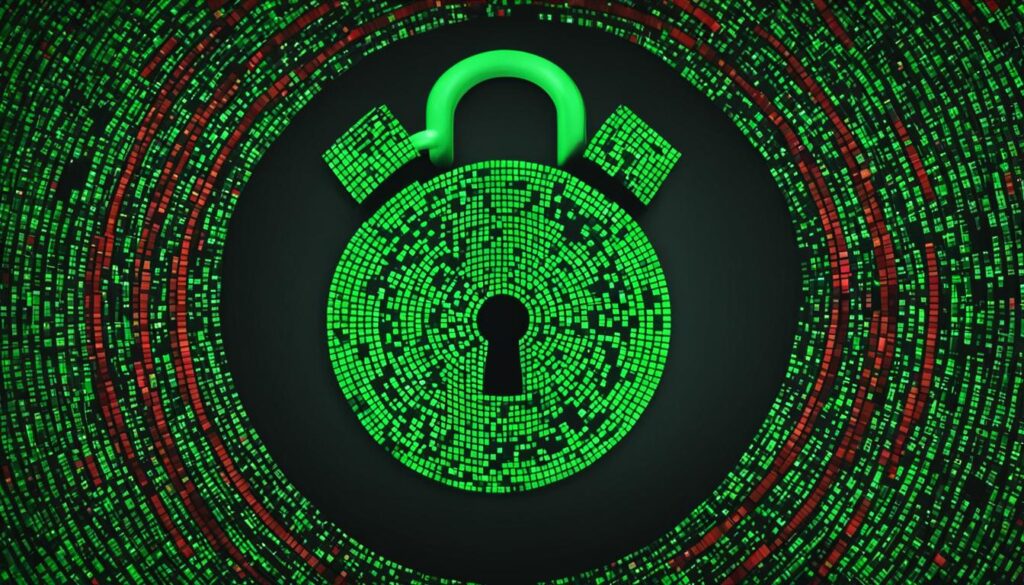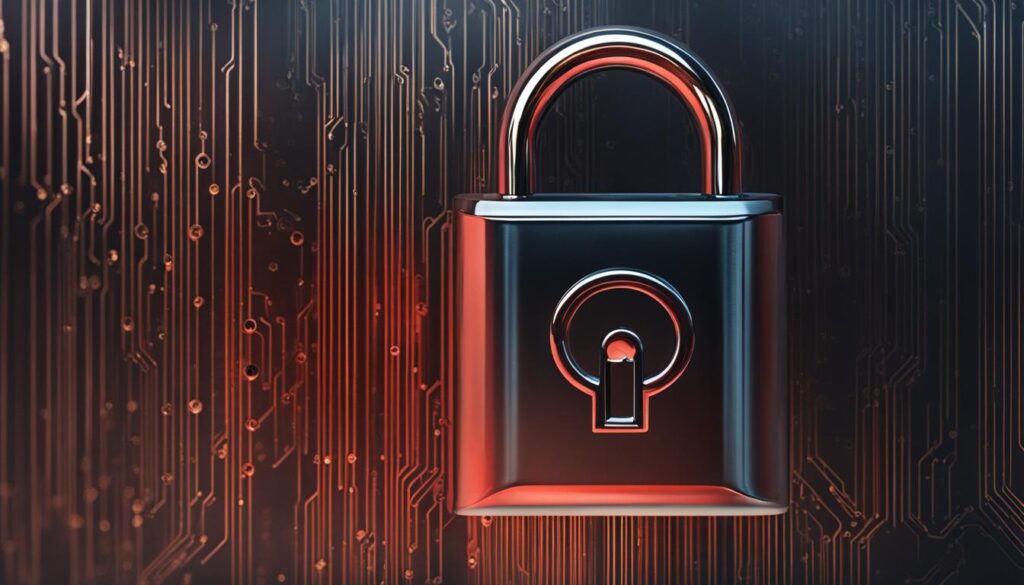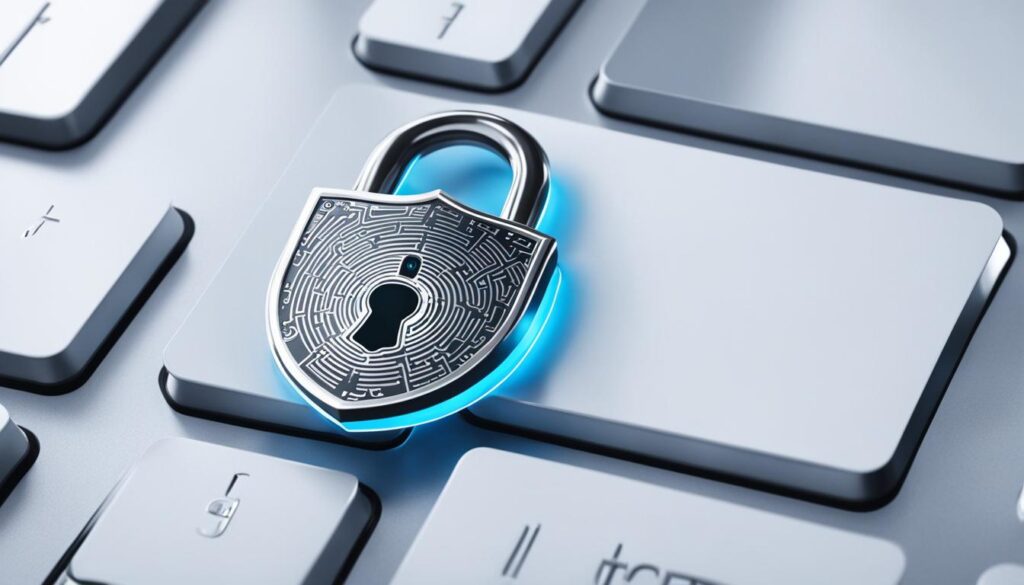Data security is of utmost importance in today’s digital age. With the increasing number of cyberattacks and the value of data, organizations need to prioritize safeguarding their digital assets. One essential tool in ensuring data security is a software security checkpoint. By implementing software security measures, organizations can protect their data from vulnerabilities and potential breaches.
Key Takeaways:
- Implementing a software security checkpoint is crucial for protecting your data.
- Software security measures help safeguard digital assets from vulnerabilities and breaches.
- Following software security best practices and protocols enhances data security.
- Regular software security auditing and vulnerability assessments can identify and address weaknesses.
- Secure software development, scanning, and testing are essential components of robust data security.
The Importance of Data Security in Today’s Digital Age
Data security plays a critical role in safeguarding sensitive information in today’s digital landscape. As cyberattacks continue to increase in sophistication and frequency, organizations face significant risks to their data and operations. Protecting data is not only essential for maintaining the trust and reputation of an organization, but it also has financial implications and ensures compliance with regulatory frameworks.
Cybercriminals view data as a valuable asset that can be exploited for personal gain or sold on the dark web. Sensitive information such as customer data, financial records, intellectual property, and trade secrets are prime targets. A single data breach can have severe consequences, including financial loss, damage to brand reputation, and legal liabilities.
Various types of cyberattacks pose significant threats to data security. Phishing attacks attempt to trick individuals into sharing sensitive information, while ransomware attacks encrypt data and demand a ransom for its release. Hacking involves unauthorized access to systems or networks, while insider threats exploit internal access privileges for malicious purposes.
“Data breaches can have a lasting impact on an organization’s reputation, eroding customer trust and leading to significant financial losses.”
To mitigate these risks, organizations must prioritize data security measures. Robust security protocols, including firewalls, intrusion detection systems, and encryption techniques, help protect data from unauthorized access. Regular vulnerability assessments and security testing are crucial for identifying and addressing any potential weaknesses or vulnerabilities in the system.
“Implementing strong data security measures is essential for compliance with regulatory frameworks.”
Regulatory compliance is a vital aspect of data security. Organizations must adhere to industry regulations such as the General Data Protection Regulation (GDPR), Payment Card Industry Data Security Standard (PCI DSS), and Health Insurance Portability and Accessibility Act (HIPAA). Failure to comply with these regulations can result in severe penalties and reputational damage.
“Data security is a continuous process, requiring constant monitoring and updates to stay ahead of evolving cyber threats.”
By prioritizing data security, organizations can protect their most valuable assets, maintain their reputation, and ensure financial stability. Ongoing investment in secure software checkpoints, robust security measures, and regulatory compliance is essential to stay ahead of cyber threats and safeguard sensitive data.
“Data security is not optional; it is a necessity in today’s digital age.”

Key Points:
- Data security is essential for preserving an organization’s reputation and financial stability.
- Cybercriminals target sensitive data through various cyberattack methods.
- Implementing robust security measures is necessary to protect data from unauthorized access.
- Compliance with regulatory frameworks is crucial for data security.
- Ongoing monitoring and updates are necessary to stay ahead of evolving cyber threats.
Data Security vs. Data Privacy
Data security and data privacy are two crucial aspects of protecting sensitive information in today’s digital landscape. Although often used interchangeably, these concepts have distinct focuses and objectives. While data security entails safeguarding data from unauthorized users and external threats, data privacy concerns the appropriate handling and management of sensitive information.
To ensure data security, organizations implement various measures such as access controls, encryption, and monitoring systems to prevent unauthorized access, data breaches, and other malicious activities. The aim is to protect sensitive data from being compromised or exploited by outside attackers.
Data privacy, on the other hand, revolves around controlling access to sensitive information, even within an organization. It emphasizes the need to manage data in a way that honors individual privacy rights and complies with relevant regulations. Data privacy measures ensure that only authorized personnel have access to specific data, reducing the risk of insider threats and unauthorized disclosure.
Access control plays a vital role in both data security and data privacy. By implementing access control mechanisms, organizations can define and enforce who has the authority to access, modify, or transmit sensitive data. This helps maintain the confidentiality, integrity, and availability of the data, ensuring that sensitive information remains protected.
In summary, data security focuses on protecting data from unauthorized access and external threats, while data privacy emphasizes the proper handling and access management of sensitive information. Both aspects are essential for organizations to maintain the confidentiality, integrity, and availability of their data, and they rely on access control mechanisms to achieve these objectives.
Types of Data Security Solutions and Techniques
To protect valuable data, organizations need to implement a range of effective data security solutions and techniques. These measures help safeguard sensitive information from unauthorized access and potential cyber threats. Let’s explore some of the key solutions and techniques:
Data Discovery and Classification
Data discovery and classification tools play a crucial role in identifying and categorizing data. By understanding the nature and sensitivity of data, organizations can implement appropriate security controls and protocols. This helps ensure that data is adequately protected based on its classification.
Data Protection Techniques
Data protection techniques involve various methods to secure data from unauthorized access. These techniques include:
- Encryption: Encryption converts data into an unreadable format, making it inaccessible to unauthorized users unless they possess the decryption key.
- Minimization: Minimization involves reducing the amount of data collected and stored, which reduces the overall risk of data breaches.
- Masking: Masking involves altering data by replacing certain values with fictitious data, ensuring that the original information remains concealed.
- Tokenization: Tokenization replaces sensitive data with unique tokens, which retain the functionality of the original data but pose no risk if intercepted.
- Anonymization: Anonymization removes or modifies identifiers from data, ensuring that individuals cannot be directly identified.
By employing these data protection techniques, organizations can significantly enhance their data security posture.
In Summary, data security solutions and techniques, including data discovery, encryption, minimization, masking, tokenization, and anonymization, play a crucial role in safeguarding sensitive information. Implementing these measures enhances data protection, ensuring that valuable data remains secure from unauthorized access.

Data Security Solutions
Implementing effective data security solutions is crucial for organizations to safeguard their sensitive information and mitigate potential security threats. By utilizing advanced technologies and strategies, businesses can ensure the integrity, confidentiality, and availability of their valuable data.
File and Activity Monitoring
A key component of data security solutions is file and activity monitoring. These tools track user behavior and monitor file access, allowing organizations to identify and respond to potential security risks promptly. By analyzing user actions and flagging suspicious activities, file and activity monitoring tools provide valuable insights into data breaches or unauthorized access attempts.
“Implementing file and activity monitoring enables organizations to detect abnormal data access patterns, unauthorized file transfers, or potential insider threats, enhancing overall data security.” – Alex Johnson, Chief Information Security Officer at SecureBytes
Vulnerability Management
Another essential aspect of data security solutions is vulnerability management. Vulnerability management tools help organizations proactively identify and assess security issues that could compromise data security. By conducting regular vulnerability scans and assessments, businesses can identify vulnerabilities in their systems or applications and take appropriate measures to mitigate or eliminate them.
“Vulnerability management plays a critical role in ensuring data security. By identifying and addressing system vulnerabilities, organizations can significantly reduce the risk of data breaches and fortify their overall security posture.” – Sarah Thompson, Senior IT Consultant at Securitech Solutions
Combining Forces for Robust Data Security
While file and activity monitoring and vulnerability management are vital components of data security solutions, they are most effective when used in conjunction with other security measures, such as access controls, encryption, and regular security audits. By implementing a layered approach to data security, organizations can create a robust defense against cyber threats and protect their valuable data from unauthorized access, breaches, or leaks.
| Data Security Solution | Key Benefits |
|---|---|
| File and Activity Monitoring |
|
| Vulnerability Management |
|
By leveraging data security solutions like file and activity monitoring and vulnerability management, organizations can significantly strengthen their data security measures. These solutions provide insights into potential security threats, enabling businesses to take proactive steps to protect their sensitive information and maintain compliance with industry regulations.

Best Practices for Data Security
Effective data security is essential for protecting sensitive information and maintaining the integrity of your organization. By implementing data security best practices, you can significantly reduce the risk of data breaches and ensure compliance with regulatory requirements.
Here are some key best practices that every organization should consider:
- Data Classification: Classify your data based on its sensitivity and importance. This allows you to prioritize security measures and allocate resources accordingly. By identifying and categorizing your data, you can implement appropriate security controls and ensure that the most critical information is adequately protected.
- Encryption: Implement encryption techniques to safeguard your data both at rest and in transit. Encryption ensures that even if unauthorized individuals gain access to your data, they won’t be able to read or decipher the information without the encryption keys. This provides an additional layer of protection against potential threats.
- Data Loss Prevention: Deploy comprehensive data loss prevention (DLP) measures to monitor, detect, and prevent data leakage. DLP solutions help identify and mitigate the transmission of sensitive data outside authorized networks, reducing the risk of data breaches.
- Least Privilege: Implement the principle of least privilege, ensuring that individuals have the minimum level of access required to perform their job functions. By limiting access privileges to only what is necessary, you reduce the likelihood of unauthorized data access or accidental data exposure.
- Secure User Accounts: Enforce strong password policies and multi-factor authentication (MFA) to protect user accounts from unauthorized access. Regularly review and revoke access for inactive or terminated employees. This helps minimize the risk of unauthorized access to sensitive information.
- Employee Training: Provide comprehensive security awareness and training programs for employees. Educate them about the importance of data security, common attack vectors, and best practices for handling sensitive information. By fostering a security-conscious workforce, you can create a strong line of defense against potential data security threats.
“Implementing data security best practices is like building a fortress around your organization’s valuable information. It’s essential to prioritize and implement the necessary security measures to safeguard against potential threats and maintain regulatory compliance.”
Data Security Best Practices
| Best Practice | Description |
|---|---|
| Data Classification | Classify data based on sensitivity and importance to prioritize security measures. |
| Encryption | Implement encryption techniques to protect data at rest and in transit. |
| Data Loss Prevention | Deploy solutions to monitor, detect, and prevent data leakage. |
| Least Privilege | Limit access privileges to minimize unauthorized data access. |
| Secure User Accounts | Enforce strong passwords, multi-factor authentication, and regular access reviews. |
| Employee Training | Provide comprehensive security awareness and training programs. |
By adopting these best practices, organizations can significantly enhance their data security posture and better protect their valuable assets from potential threats.

Data Security Regulations
Organizations must adhere to specific data security regulations to safeguard sensitive customer data and ensure compliance. The following are some prominent data security regulations:
- General Data Protection Regulation (GDPR): The GDPR is a comprehensive data protection law in the European Union (EU) that governs the processing and transfer of personal data. It imposes strict requirements on organizations to ensure the privacy and security of individuals’ data.
- Payment Card Industry Data Security Standard (PCI DSS): PCI DSS sets the security standards for organizations that handle payment card information. Compliance with PCI DSS ensures secure processing, transmission, and storage of cardholder data, reducing the risk of card fraud and data breaches.
- Health Insurance Portability and Accessibility Act (HIPAA): HIPAA establishes regulations for protecting the privacy and security of individuals’ health information. It applies to healthcare providers, health plans, and healthcare clearinghouses, ensuring the confidentiality and integrity of patients’ sensitive data.
Complying with these data security regulations is essential to prevent data breaches, protect customer privacy, and avoid potential legal and financial consequences.

Data Security with Check Point
When it comes to safeguarding your organization’s data, Check Point offers comprehensive data security solutions, including cloud security. With Check Point CloudGuard, you can ensure the protection of your cloud-based data, defending against data breaches and enhancing data protection in cloud environments.
Cloud computing has become an integral part of modern business operations, providing flexibility and scalability. However, it also introduces unique vulnerabilities and risks to data security. With the increasing number of data breaches, organizations need robust security measures to protect their sensitive information.
Check Point understands the importance of data security in the cloud era and provides advanced solutions to mitigate these risks. By leveraging industry-leading technologies and expertise, Check Point CloudGuard enables organizations to establish strong defenses against unauthorized access, data breaches, and other potential cyber threats.
Key Features of Check Point CloudGuard:
- Data Breach Prevention: Protects sensitive data from unauthorized access and data breaches.
- Cloud Visibility and Control: Provides visibility and control over cloud-based assets, ensuring compliance with data protection regulations.
- Real-Time Threat Intelligence: Utilizes real-time threat intelligence to detect and respond to emerging threats.
- Secure Cloud Migration: Facilitates secure migration of workloads to the cloud without compromising data security.
Check Point CloudGuard offers a holistic approach to cloud security, addressing both external and internal threats. It integrates seamlessly with leading cloud platforms, including Amazon Web Services (AWS), Microsoft Azure, and Google Cloud Platform (GCP).
By choosing Check Point as your data security partner, you can have confidence in the protection of your valuable data in the cloud environment. With Check Point CloudGuard, your organization can stay resilient against data breaches and maintain the highest level of data protection.

Quote:
“Check Point CloudGuard has been instrumental in safeguarding our cloud-based data. Its advanced security features and seamless integration with cloud platforms have provided us with peace of mind.” – John Smith, Chief Information Officer at ABC Corporation
Security Management
In order to ensure effective protection against cyber threats, Check Point has implemented a robust security management framework. This framework encompasses administrative, technical, and physical safeguards, providing comprehensive security measures for your organization’s data.
Administrative safeguards involve the implementation of policies, procedures, and training to ensure that employees are aware of their roles and responsibilities in maintaining data security. Technical safeguards include the use of advanced technologies and tools to protect against unauthorized access, such as firewalls and encryption. Physical safeguards focus on securing the physical infrastructure that houses your data, such as data centers and server rooms.
Check Point’s security management program adheres to international standards such as ISO 27001, OWASP, and NIST 800-53. These standards provide guidelines and best practices for data security, ensuring that your organization implements the necessary controls to protect against cyber threats.
Benefits of Check Point’s Security Management:
- Comprehensive protection against cyber threats
- Evidence-based security controls
- Enhanced compliance with industry standards
- Protection of confidential data
- Minimization of security risks
By implementing Check Point’s security management framework, your organization can proactively manage and mitigate security risks, protecting your valuable data and ensuring compliance with data security regulations.

| Administrative Safeguards | Technical Safeguards | Physical Safeguards |
|---|---|---|
| Policies and procedures | Firewalls | Access controls |
| Employee training | Encryption | Surveillance |
| Security awareness programs | Intrusion detection systems | Physical access restrictions |
Personnel Security
At Check Point, we understand the critical importance of personnel security in maintaining a strong defense against data breaches and cyber threats. We prioritize the vetting and training of our employees to ensure the highest level of protection for our clients’ sensitive information.
As part of our personnel security measures, we conduct thorough background checks on all prospective employees. These checks include verification of identity, employment history, educational qualifications, and criminal records. By performing these checks, we strive to hire trustworthy individuals who will uphold our commitment to data security.
In addition to background checks, we provide comprehensive security training to our employees. Our training programs are tailored to each employee’s role and responsibilities, equipping them with the knowledge and skills to identify and respond to various security threats effectively. We believe that ongoing education is essential in maintaining a vigilant and security-focused workforce.
Confidentiality is central to our personnel security practices. We require all employees to sign confidentiality agreements that legally bind them to protect sensitive information during and after their employment with Check Point. These agreements serve as a crucial safeguard against unauthorized disclosure, reinforcing the trust our clients place in us.
By prioritizing personnel security through background checks, security training, and confidentiality agreements, Check Point establishes a robust defense against potential internal threats and ensures that our clients’ data remains safe and secure.
Internal Access Controls
Check Point recognizes the criticality of internal access controls to safeguard Personal Data against unauthorized access. Our robust internal access controls are designed to ensure that individuals can only access data that is necessary for their roles, adhering to the principle of least privilege.
By implementing internal access controls, we significantly reduce the risk of unauthorized data exposure or misuse. These controls restrict access to sensitive information to only those who require it in their daily work.
Access authorization is a continuous process at Check Point, and we regularly review and update access privileges based on changing roles, responsibilities, and project requirements. This ongoing assessment ensures that access is granted or revoked promptly, aligning with the need-to-know principle.
Account authentication is another critical aspect of our internal access controls. We enforce strong authentication mechanisms, including multi-factor authentication, to prevent unauthorized access to sensitive information. By implementing these measures, we ensure that only authenticated users can access Personal Data.
Benefits of Internal Access Controls
- Protection against unauthorized access to Personal Data
- Reduces the risk of data exposure or misuse
- Ensures employees only have access to data necessary for their roles
- Regular review of access privileges based on changing requirements
- Enforcement of robust account authentication mechanisms
Implementing strong internal access controls is crucial to maintaining data security and privacy. It not only safeguards sensitive information but also demonstrates our commitment to data protection and compliance.
Protecting sensitive information through internal access controls is vital for your organization’s data security. Implementing the need-to-know principle, least privilege approach, access authorization, and robust account authentication helps prevent unauthorized access to Personal Data.
Physical and Network Security Measures
To ensure the utmost protection for your data, Check Point employs a combination of physical and network security measures. These measures serve as essential safeguards against unauthorized access and potential cybersecurity threats.
Physical Security
Check Point prioritizes physical security by implementing stringent access controls within areas that process Personal Data. Restricted access to these critical areas minimizes the risk of unauthorized individuals gaining physical access to sensitive information.
Additionally, surveillance systems are deployed to monitor and record activities within relevant premises. These surveillance measures enhance security by providing real-time monitoring and providing valuable footage for investigative purposes if needed.
Network Security
Network security is a vital component of safeguarding data from external threats. Check Point utilizes state-of-the-art network security measures to ensure the integrity, confidentiality, and availability of your data.
A robust firewall system is in place to monitor and control network traffic, preventing unauthorized access and filtering out potential threats. This technology acts as a barrier between your network and the internet, actively scanning for any suspicious activities or malicious traffic.
Moreover, cryptography plays a crucial role in protecting data during transmission. Check Point implements strong encryption algorithms to secure network communications, providing an additional layer of defense against eavesdropping and data interception.
Intrusion detection systems are employed to detect and respond promptly to any unauthorized attempts to access the network. These systems continuously monitor network traffic, identifying unusual activities and raising alerts when potential security breaches are detected.
In addition, regular vulnerability scans are conducted to proactively identify any weaknesses or vulnerabilities in the network infrastructure. These scans help ensure that necessary patches and updates are implemented promptly, reducing the risk of exploitation by cybercriminals.
“By combining physical security measures and robust network security technologies, Check Point offers comprehensive protection for your data, minimizing the risk of unauthorized access and potential breaches. With our advanced security solutions, you can have confidence in the integrity and confidentiality of your digital assets.”
| Physical Security Measures | Network Security Measures |
|---|---|
| Restricted Access Controls | Firewall System |
| Surveillance Systems | Cryptography |
| Intrusion Detection Systems | |
| Vulnerability Scans |
Conclusion
Ensuring the security and protection of your organization’s data is of utmost importance in today’s digital landscape. By implementing a software security checkpoint and adhering to data security best practices, you can mitigate the risks of cyber threats and comply with regulatory requirements.
By adopting comprehensive security measures, you can safeguard your digital assets and avoid the devastating consequences of data breaches. Protecting sensitive information is not only essential for maintaining the trust and reputation of your organization but also for safeguarding your financial stability.
Remember to prioritize data security by implementing secure software checkpoints, conducting regular vulnerability assessments, and staying up-to-date on the latest security protocols. By proactively addressing potential vulnerabilities and following data security compliance regulations, you can enhance your overall data security posture and protect both your organization and your valued customers.
FAQ
What is a software security checkpoint?
A software security checkpoint is a measure or protocol implemented to ensure the security and integrity of software systems. It helps protect against cyberattacks, vulnerabilities, and unauthorized access, ensuring the safety of your data and digital assets.
What are some best practices for software security?
Some best practices for software security include secure software development, regular software vulnerability assessments and audits, implementing secure coding practices, conducting software security testing, and regularly updating and patching software to address any security vulnerabilities.
How can I assess the security of my software?
You can assess the security of your software by conducting software security scanning and testing. This involves identifying and analyzing potential security vulnerabilities and weaknesses in your software, such as code vulnerabilities, configuration issues, and access control vulnerabilities.
What are common software security measures?
Common software security measures include implementing secure coding practices, using strong authentication and access controls, employing encryption for sensitive data, regularly updating and patching software, utilizing firewalls and intrusion detection systems, and conducting regular security audits and vulnerability assessments.
How can software security help protect my data?
Software security helps protect your data by preventing unauthorized access, detecting and mitigating security vulnerabilities, and safeguarding against cyberattacks and data breaches. Implementing software security measures ensures the confidentiality, integrity, and availability of your data resources.
What is the importance of software security in compliance with regulations?
Software security is crucial for compliance with regulations such as GDPR, PCI DSS, and HIPAA. These regulations require organizations to implement adequate security measures to protect sensitive data and ensure the privacy and rights of individuals. Failing to meet these standards can result in significant financial penalties and reputational damage.





